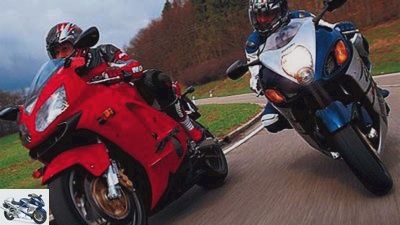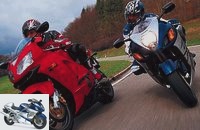Menus

Gargolov
Comparison test between Kawasaki ZX-12R and Suzuki GSX 1300 R Hayabusa
Railway crusher
Once they showed the way to 300 km / h. Are the two renovated top performers well equipped for a life this side of the sound barrier?
The Kawasaki ZX12-R always played the tragic heroine of the supersonic bikes, as it never quite managed to teach the speed-300 revolutionary Suzuki Hayabusa the announced lesson. The GSX always appeared more binding in terms of its chassis, the Kawa remained the reputation of the rough utility. That should change in 2002, the Greens report over 140 changes to their top model, while the Hayabusa is limited to G-Kat and other color combinations as innovations.
Far-reaching facial surgery, on the other hand, with the fast ninja: modified panel shape including dome-shaped pane, more compact mirrors, 30 percent larger ram air inlet. This means that the twelve now looks more dynamic and smart than before from the reshaped twin headlights, while the Hayabusa promises to slide organically round through the elements as usual.
When it comes to inner-city stop-and-go cucumber, however, other talents are required. Such as flawless cold running and clean throttle response. The Hayabusa would like to be carefully directed through the heavy traffic with gas and the difficult-to-grip clutch, the liason of the more responsive ZX-12R engine with its flawless clutch requires less concentration. The Kawasaki people have succeeded in noticeably releasing the previously annoying tolerances in the drive train and thus improving load changes and responsiveness. In addition, the ZX-12R rider sits upright and relaxed behind the dummy fuel tank, while the Suzuki is more sporty because of the smaller leg angle and the differently positioned handlebar halves.
On winding terrain, it becomes clear that Kawasaki has also done its homework on the chassis side. Reduced misalignment of the triple clamps, longer caster, deeper swing arm mounts on the monocoque frame, shorter strut with softer spring, rear lift by means of a two millimeter thick spacer as well as more pointed contoured Dunlop D 208 instead of D 207 are effective. The current twelve flies more smoothly and neutrally across the country than the previous model. Although the fast ninja does not offer the lightness of a Honda VFR of the same weight, it masters even tricky combinations of corners without fuss. Even bends are relatively flaky by hand.
The Hayabusa doesn’t love it that much. As soon as fast steering impulses are on the agenda, the standard steering damper always has a somewhat calming effect, especially at low temperatures. Understandably, the Hayabusa was the first serial 300 km / h killer, and the engineers didn’t want to miss anything. In other words: steadfast directional stability, no kickback. Indeed, the handlebars remain steady even when accelerating at breakneck speed over powerful asphalt breakers. The GSX prefers to click in wide arcs, gliding from curve to curve. Due to the tire contour of the mounted Bridgestone BT 56, changing the lean angle is easy. Even at high speeds, the Haya can be directed cleanly and precisely.
Just like the ZX-12R, it only reacts badly to bumps in a sloping position, despite its ample damping reserves? a consequence of the wide rear tires. For whose contact area you are grateful for when you quickly apply the gas. Because who has the power lurking in every speed range? Starting at 4000 rpm, both have around 100 Newton meters of torque, from 6000 rpm 100 PS ready – vehemently letting go of the asphalt, more rubber is grateful for every square millimeter. Just don’t go crazy, is the motto when it comes to 100 and 7.2 (ZX-12R), or 7.4 seconds (GSX) to 200 km / h on the single-track missiles. Incidentally, without the sprint spook being over.
The passage through the adventure is more practical than the academic sprint for the gallery. Here, even average bikers can get drunk on the power and glory of exuberant performance. Without the risk of hangovers or side effects. Well, maybe a bit addicting. Well. The cables are taut, and even in sixth gear, both power bolts push forward with an emphatic vehemence that is stored under “acceleration” on standard human hard drives. Just like that, loosely flaky on the wrist. From 60 to 295 without shifting. Passengers cheer. Usually out of joy. Especially in third gear, in which the supposed beasts dive playstation-like to 240 km / h without the risk of rollover or rubber smoke. And hardly let the extra weight of a passenger slow you down.
So don’t be surprised if a three-finger pointer comes from behind from time to time in the future. Fulfill your passenger’s desire for an intermediate sprint. After all, both pillion seats require willingness to make sacrifices, whereby the higher Kawa arrangement promises a better overview, the lower Suzuki seat promises significantly more seating comfort as well as better holding options and wind protection. Thanks to the chassis data, “play it safe”, a horizontal “roller coaster feeling” including tingling in the stomach is guaranteed at all times, without having to bump the handlebars into account. While the Suzuki front sticks bomb-proof on the asphalt, even with a full crew, the Kawa can be carried away with minimal unrest on an undulating road. However, these provide more amusement than sweat of fear.
What can be ascribed to a controlled traction. In this regard, the 2002 ZX-12R has developed into a highly committed partner. The chassis operates smoothly, directly and smoothly, without suppressing the necessary information from the popometer. Even neglected side streets are no longer a restricted area for Kawa tourists. They have never been that for the Hayabusa workforce, whose clean, appealing and well-balanced spring elements cut a fine figure even on the worst road surface. Incidentally, both chassis are fully adjustable and can handle the entire repertoire from hard to delicate with reserves for accelerated country road speeds, solo or in pairs.
Uuuund – of course, highway turf. As before, the special charm of 170 hp two-wheelers also unfolds in inverse proportion to speed restrictions and traffic density. The following applies to both test subjects: The purchase contract counts as a season ticket for the use of breathtaking single-track rides with relentless forward thrust. Especially with the Kawasaki, which doesn’t get tired even on top ?? whether the promised increase in performance is due to Ram-Air? Regardless of how, the Hayabusa also speeds up to the last marking line on the speedometer to be intercepted by the speed limiter.
However, staying within striking distance of the sound barrier is not a real pleasure for the GSX pilot. Windbreak? Sure, but only if you fix yourself flat on the tank. Otherwise, it means bravely braving the oncoming elements. After all: there is no disturbing turbulence, and a bull’s neck can also be very sexy, right? Behind the dome-shaped Kawa disc, you can live well even at tempos beyond the 280 mark.
Until the first van pulls from the middle to the left lane and parks at 160 km / h. It’s good that the six-piston Tokicos can bite powerfully. With a convincing effect and clearly defined controllability, they keep the 248 kilograms of the Kawa plus Pilot in check, even at crazy speeds. The Suzuki stoppers with the discs go into the clinch much more wooden. They require more hand strength and are more difficult to dose.
By the way, it is cute to see how the standard consumption display of the Hayabusa falls from the usual 14 kilometers per liter to the single-digit range at hell’s speed. Both speed kings have to refuel every three quarters of an hour under full load. Pleasurable country road driving costs just under seven liters of Super per 100 kilometers. Quite a bit, but you can’t get a rollercoaster ride for one euro either.
GThose eager to learn can console themselves with the exhaust gas cleaning system. U-Kat-cleaned emissions escape from the titanic four-in-one horn of the Kawasaki, while the Suzuki filters with G-Kat. Secondary air systems have both, the pollutant values of the Suzuki are cheaper than those of the Kawa because of the more complex filtering. Their headlights counter with better light output, although the hayabus double-decker solution of open-space low beam and projection high beam also has an illuminating effect on night trips. And luggage hooks and useful storage compartments both also have on board. If the speed trip should take a little longer.
Buy complete article

Comparison test between Kawasaki ZX-12R and Suzuki GSX 1300 R Hayabusa
Railway crusher
1st place – Kawasaki ZX-12R
Was it faster? before the 300 limit ?? Anyway, after the complete overhaul, the Kawasaki Queen can finally score points in terms of chassis in the second attempt. And leave long-term rival Hayabusa, all in all tight, behind. Handling, braking, wind protection: the progress is unmistakable. And the cost? Well, anyone who drives Zwolfer shouldn’t look at every penny anyway. And prefer to enjoy the season ticket for refreshing pace. And that on the autobahn and country road, because the previously somewhat idiosyncratic ZX-12R is now one of the hot candidates.
2nd place – Suzuki GSX 1300 R Hayabusa
Hayabusa – She is and remains the icon of all speed junkies. After all, she was the first to jump over the 300 km / h hurdle without much fuss, without weakening in subsonic operation. It’s nice that the whole thing can be regulated continuously with the throttle. Elements falling unrestrainedly over the pilot and scary, roaring suction sipping alternate with the quiet hum of the power block relaxing while swinging the country road in the sixth, passengers are welcome. The supposed monster is actually a great touring athlete? now even with a regulated catalytic converter.
Related articles
-
The best athletes in the country road comparison Honda CBR 600 F, Suzuki GSX-R 750, Kawasaki ZX-9R, Aprilia RSV Mille, Suzuki GSX 1300 R Hayabusa Magic…
-
Gargolov Comparison test big bikes: Honda CBR 1100 XX Super Blackbird, Kawasaki Ninja ZX-12R, Suzuki GSX 1300 R Hayabusa, Yamaha FJR 1300 A Two fast, two…
-
Jahn 35 pictures Jahn 1/35 Husqvarna TC 250 R in the motocross comparison test. Jahn 2/35 Yamaha YZ 250 F in the motocross comparison test. Jahn 3/35 Husqvarna TC …
-
Comparison test between Kawasaki GPX 600 R and Suzuki GSX 600 F
Comparison test between Kawasaki GPX 600 R and Suzuki GSX 600 F Signs of aging What they may lack in youthful resilience after more than ten years of…
-
Comparison test BMW K 1300 S, Kawasaki ZZR 1400, Suzuki Hayabusa 1300
Gargolov Comparison test BMW K 1300 S, Kawasaki ZZR 1400, Suzuki Hayabusa 1300 Speed bikes in comparison The wind tunnel formed their faces, their…
-
Suzuki Hayabusa, Kawasaki Ninja H2, Aprilia RSV4 RF and Yamaha Vmax in the test
Bilski 41 photos Bilski 1/41 Yamaha Vmax, Suzuki Hayabusa, Aprilia RSV4 RF, Kawasaki Ninja H2. Each of these four machines has its own special charm….
-
Comparison test between Kawasaki ZX-9R and Suzuki TL 1000 R
Comparison test between Kawasaki ZX-9R and Suzuki TL 1000 R How you take it Finally: the Suzuki TL 1000 R wants to make V-Twin fascination affordable….
-
Comparison test between Kawasaki VN 800 Classic and Suzuki VZ 800 Marauder
Comparison test, Kawasaki VN 800 Classic, Suzuki VZ 800 Marauder Kawasaki VN 800 Classic versus Suzuki VZ 800 Marauder Kawasaki VN 800 and Suzuki VZ 800…
-
BMW K 1200 S against Honda CBR 1100 XX, Kawasaki ZX-12R and Suzuki Hayabusa
fact BMW K 1200 S against Honda CBR 1100 XX, Kawasaki ZX-12R and Suzuki Hayabusa The strongest temptation Ever since BMW motorcycles have existed, the K…
-
High-speed test Suzuki GSX-R 1300 Hayabusa
High-speed test Suzuki GSX-R 1300 Hayabusa 312 It is moving forward, without a doubt! The Suzuki GSX-R 1300 Hayabusa should also enable ordinary people…